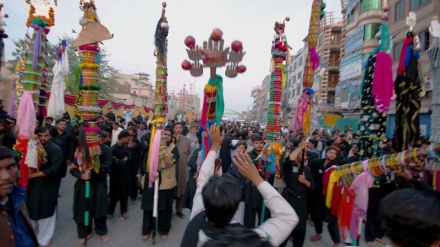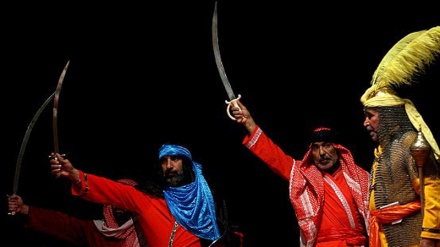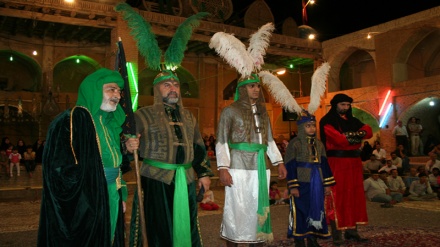Muharram mourning traditions in different lands - 13
In this series, which delves into the various mourning traditions associated with the Immortal Epic of Ashura in various lands, we look at the earliest history of mourning for Imam Husain (AS).
With the rise of Shah Ismail in 1499 AD, Iran not just emerged as a national state but saw the revival on a grand scale of the culture and message of Muharram that had inspired the Qizilbash movement to struggle against social injustice. During the Safavid period, the Muharram commemorative rites which had been publically practiced since the past 8 centuries became a manifestation of state power. In many respects, the Safavids owed their political success in Iran to the teachings of the Prophet's Ahl al-Bayt that had become a wave of inspiration for the people, particularly among the Turkic tribes in the areas of northwestern Iran, the Caucasus, and eastern Anatolia or what is now Turkey, in addition to Iraq.
This paved the way to foster a stronger set of ritualized behaviour within the Islamic practices of collective pilgrimage and ritual commemoration. An important aspect of the Muharram observances of the Safavid era is the expanded scope of people’s participation in the performance of this ritual. In Muslim law, collectivity is required in several specific performances such as the Friday prayer and the Two Eid Prayers, as well as the Hajj pilgrimage. In addition, the Shari’ah approves collective funeral and memorial services, which means there can be no greater collective tribute for the departed than the martyrs of history's most heartrending tragedy, and that too, when the Chief of Martyrs is none other than Imam Husain (AS), the grandson of Prophet Mohammad (SAWA).
It was adherence to the path of the Ahl al-Bayt and commemoration of the tragedy of Karbala that inspired the Safavids and the Iranians to preserve Iran's national identity, territorial integrity, religious unity, and cultural affinity, in the face of over two centuries of fierce but vain attempts to expand in the east by the Ottoman Empire which had conquered the Arab World and overrun most of southwest Europe. The popularizing of the culture of Ashura in society and public mourning ceremonies for the Martyrs of Karbala, thus became the most invaluable asset of the Iranian society. Shah Tahmasb the First, the second Safavid emperor, was attracted to religious poetry and during his long 50-plus reign, encouraged all poets to compose poems in praise of the Prophet’s Household. The Safavid rulers generally did not appreciate flattery.
They did not want poems in praise of themselves, rather they encouraged poets to compose poems on the God-given merits of the Ahl al-Bayt (AS). Thus the genre of noha-khwani and marthiya-khwani, or elegies for the martyrs of Karbala, assumed new dimensions. In particular, the famous Iranian poet, Mohtasham Kashani, who flourished in the Safavid era, composed many well-known and beautiful poems in praise of the Prophet’s Household. His moving verses are frequently used till this day, in Muharram mourning ceremonies for the martyrs of Karbala. Mohtasham’s fame today rests almost entirely on a single poem—his elegy in twelve strophes (or davazdah-band) on the martyrdom of Imam Ḥusain (AS). It begins with the words: Baaz in che shureshi-st ke dar ḵhalq-e alam ast, Baaz in che nowha o che aza o che matam ast. Translated into English it means: "What is this agitation anew in the whole creation? What now is this wailing, this mourning, this lamentation about?”
Another of his famous couplet reads: “This land full of hardship is called Karbala; O the indifferent heart! Where's your sky-burning cry?”
Even European travelers to Iran have noted the impact on the public of the commemorative gatherings of the mourning month of Muharram. These accounts demonstrate that most elements of the “dasta gardani” rituals existed during the reign of Shah Abbas I. Dasta gardani requires preparations to form dastas or groups and involves rallying the grieving volunteers of a special quarter, or of a professional group in a city, who then walk and parade with special banners and standards. The Italian traveler Pietro della Valle, who visited Isfahan in 1025 AH, corresponding to 1616 AD, has described the Ashura observance as the largest ceremony in which huge groups or factions were present with special banners and standards. Each group was equipped with several horses and camel-litters surrounded by a group of mace-bearers. Closing the shops of the bazaar functioned as a prerequisite for the Muharram ceremonies due to the public processions or dasta gardani which had become an essential part of mourning rites since the mid-Safavid period.
Under Shah Abbas 1 Muharram became a major public event, an event that reflect the growing bond between state and society. The pre-Safavid commemorations of the Muharram ceremonies were never entirely to state power, nor were they organized in the form of an elaborate public event. During their long history of development, Muharram rites appear to have been limited to particular groups, sects, and factions, but the Safavid transformed these ceremonies. The post Mongol or Ilkhanid period, however, witnessed a major development in the ceremonies, as the rituals became increasingly public affair, Muharram began to transcend sectarian factionalism, as the love of the Ahl al-Bayt among the masses, gradually spread throughout the Iranian Plateau, Anatolia, the Caucasus, and the Subcontinent.
Thus, the Safavids institutionalized the Muharram mourning ceremonies. For instance, in Isfahan, the mourning procession on the Day of Ashura would be held in the large Naqhsh-e Jahan Square, where mourners beating their chests in grief marched behind empty coffins and a string of camels with women and children seated upon them, crying and wailing to depict the family members of the Prophet’s Household, following the martyrdom of Imam Husain (AS).
MD/AS/SS


